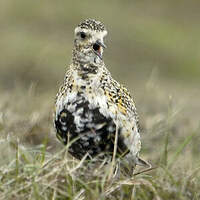European Golden Plover
Pluvialis apricaria - Pluvier doré
Identification
The European Golden Plover is a medium sized bird, typically charadriid (compact body, big head, small beak and moderate legs). In breeding plumage, its upper parts are brightly coloured black, white and a golden yellow; below, from the face to the belly, is entirely black with a wide white border beginning with a white forehead, followed by a clear white eyebrow and passing the brown ear. Females have a less deep black, with brown feathers. Furthermore, there are individual variations in the extent and quality of black, but the species is currently considered monotypic. The eye is dark. The beak and legs are dark greyish black. In winter plumage, the chest bears a greyish breast speckled with golden yellow and brown merging with the marked brown sides. The belly is white. Juveniles look very much like the adult in winter, but with grey fringes on the sides and belly coverts.
On the bird in flight, the underwing is very pale and particularly the white axillaries stands out from other species. In top view, only the slightly marked white wing bar can be seen, made up of the ends of the greater coverts and the base of the primaries.
Subspecific information monotypic species
Foreign names
- Pluvier doré,
- Chorlito dorado europeo,
- tarambola-dourada-europeia,
- Goldregenpfeifer,
- aranylile,
- Goudplevier,
- Piviere dorato,
- ljungpipare,
- Heilo,
- kulík zlatý,
- kulík zlatý,
- Hjejle,
- kapustarinta,
- daurada grossa,
- Heiðlóa,
- siewka złota,
- dzeltenais tārtiņš,
- zlata prosenka,
- Золотистая ржанка,
- ヨーロッパムナグロ,
- 欧金鸻,
- ljungpipare,
- 歐洲金斑鴴,
Voice song and call
Habitat
Spending most of its time on the ground, the European Golden Plover favors flat, open areas with short grass vegetation and no trees, where it can quickly run away in case of danger. During breeding season, typical habitats of the European Golden Plover are heathlands, tundra, and peaty fields. In winter, it frequents cultivated plains, meadows, cereal fields, plowed lands, and polders.
Behaviour character trait
Only a minority of the European Golden Plovers of the British Isles are migratory. Those that are start to gather in August, but do not leave their breeding grounds until October in order to overwinter in Ireland.
Dietfeeding habits
During reproduction, European Golden Plovers feed quite far from their nest. They eat insects, particularly Coleoptera and their larvae. When they are not tending to the eggs or young, the adults both feed and rest night and day and, winter is the prime time for the European Golden Plover, which feeds mainly on earthworms, but also slugs and grass.
Reproduction nesting
Before breeding begins, the European Golden Plover moults and takes on its more colourful nuptial plumage.
Pairs are usually formed just prior to arriving at the nesting site, and they stay together for life. Once the breeding site has been chosen, the male vigorously defends his territory against rival males intruding. The male then digs a number of shallow nesting scrapes in the ground. The female chooses one of them, and both birds go through a courtship display before mating. The nest is then enlarged by the female and lined with grass. About 3 weeks later, the female lays 3-4 eggs over a 2-day period. Incubation is shared between both adults, although to varying degrees. Sometimes the male incubates during the day, and the female at night; alternately, they take turns at regular intervals. The eggs hatch after 28-31 days. The chicks are precocial, meaning they are very well-developed at birth. Shortly after hatching, the parents lead them to nearby feeding grounds and stand guard while they feed. After a month, the young are fully feathered and can breed in the following year.Geographic range
The European Golden Plover breeds from northeastern Atlantic (east-central Greenland, Iceland, Faroe Islands, Ireland and northern British Isles) to the Taimyr Peninsula in Siberia, passing through northern Germany, Denmark, Fenno-Scandinavia and the Baltic countries. Its wintering area includes Ireland and the British Isles where the species nests and where birds are almost sedentary, as well as the coast of the North Sea (France, Belgium and Netherlands) due to the mild climate, the countries around the Mediterranean and the coasts of the Black Sea (west and south) and south of the Caspian Sea.
Threats - protection
IUCN conservation status
concern
in the Wild
threatened
evaluated
The European Golden Plover is mainly threatened by the disappearance (hydraulic works, sand-pits development, afforestation) and modification of its habitat (abandonment of traditional agricultural practices) and disturbances during the reproduction period.
Sources of information
- IOC World Bird List (v15.1), Gill, F and D Donsker (Eds). 2025-12-07.
Other sources of interest
 Specification sheet created on
25/07/2023 by Jean François
Specification sheet created on
25/07/2023 by Jean FrançoisTranslation by AI Oiseaux.net
© 1996-2025 Oiseaux.net
- Accipitriformes
- Aegotheliformes
- Anseriformes
- Apodiformes
- Apterygiformes
- Bucerotiformes
- Caprimulgiformes
- Cariamiformes
- Casuariiformes
- Charadriiformes
- Ciconiiformes
- Coliiformes
- Columbiformes
- Coraciiformes
- Cuculiformes
- Eurypygiformes
- Falconiformes
- Galliformes
- Gaviiformes
- Gruiformes
- Leptosomiformes
- Mesitornithiformes
- Musophagiformes
- Nyctibiiformes
- Opisthocomiformes
- Otidiformes
- Passeriformes
- Pelecaniformes
- Phaethontiformes
- Phoenicopteriformes
- Piciformes
- Podargiformes
- Podicipediformes
- Procellariiformes
- Psittaciformes
- Pterocliformes
- Rheiformes
- Sphenisciformes
- Steatornithiformes
- Strigiformes
- Struthioniformes
- Suliformes
- Tinamiformes
- Trogoniformes
































